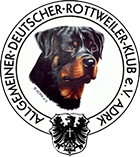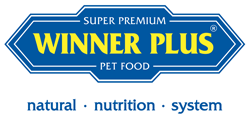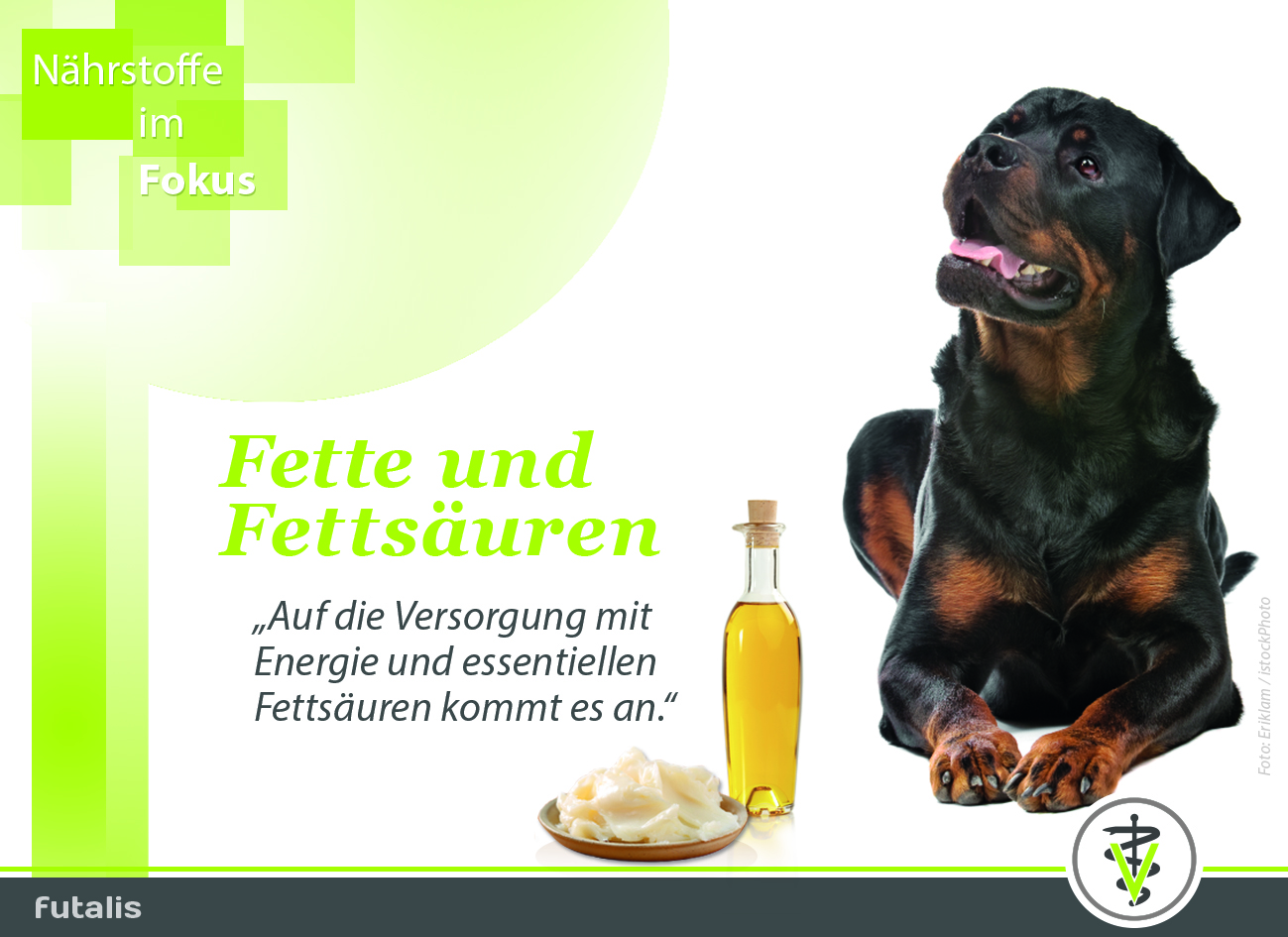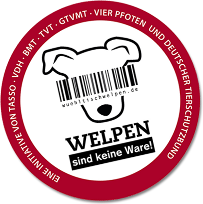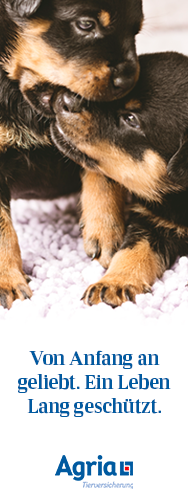| ADRK |
| Allgemeiner Deutscher Rottweiler-Klub e.V. |
Focus on nutrients fats and fatty acids
Structure of feed fats
Fats (lipids) consist of different fatty acids which are connected to each other by a glycerine molecule. The composition of these fatty acids determines whether fats are present in solid or liquid form. Oils, i.e. fats in the liquid state, are usually obtained from plants (e. g. Linseed oil, Olive oil) or fish (e.g. salmon oil, cod liver oil), while other fats of animal origin (e.g. lard, beef tallow) are present in the solid state. The different composition of the fatty acids in the animal's own fats makes it possible to classify them according to their specific chemical structure (unsaturated or saturated) or according to the size of the fatty acid chains (long-, medium- or short-chain). Also important are the so-called omega-6 and omega-3 fatty acids, which belong to the so-called "polyunsaturated fatty acids".
Tasks of fatty acids and fats in the body
Certain enzymes in the intestine are required for the digestion of fat. These so-called lipases are formed in the oral cavity, in the stomach and in the pancreas. They break down the dietary fats into the individual fatty acids so that they can be absorbed into the bloodstream. The so-called bile acids are also necessary for this process. They are formed in the liver and then enter the intestine via the gallbladder. Once the fatty acids have been absorbed into the bloodstream, they are further processed in the liver. They are incorporated into the body's own fats, for example in the skin, or stored as fat reserves in certain parts of the body. If fats are then required for energy production, the fatty acids are further broken down into simple carbon compounds and energy is released as a result.
Fatty acids perform a variety of tasks in the dog's organism. They are contained in cell membranes and thus influence the composition of various organs and body tissues, in particular the skin and mucous membranes of the urinary tract as well as the stomach and intestines, but also the body's defence is dependent on the availability of certain fatty acids. Furthermore, fats from food are needed to absorb fat-soluble vitamins (vitamins A, D, E and K) from the intestines. Excess fats are also stored in the fatty tissue, which is mainly located under the skin and in the abdominal cavity. If a lack of food occurs, these depot fats can be used to generate energy. But also against environmental influences like cold the stored body fat offers a certain protection.
Dogs are able to produce some fatty acids themselves, so only certain fatty acids have to be supplied via the food. Only the essential fatty acids, which the body cannot produce itself, must be taken up by a dog with its food. In dogs, this concerns linoleic acid and α linolenic acid. In addition, other omega-3 fatty acids are also needed, which should be contained in the food.
Fatty acids and fats in the diet of the dog
The benefit that a dog can derive from dietary fat is not only the supply of essential fatty acids, but also the energy supply is ensured. Compared to other energy-supplying nutrients, fats can be used very effectively for this purpose and thus represent a preferred source of energy for the body. But also carbohydrates and proteins will be part of the energy production, because only certain amounts of fat are tolerated in the intestines of dogs. An optimally fitting daily ration therefore contains these different energy suppliers in a balanced ratio. The individual nutrient and energy requirements as well as the individual intestinal sensitivity should be taken into account.
In addition, a high-fat food tastes better to dogs because animal fats are good flavour carriers. In certain life situations, however, a reduced fat content may be indicated. These include, for example, overweight, a malfunction of the pancreas or excessive blood fat levels.
Possible mistakes and their consequences
An insufficient amount of feed fats is initially compensated by the utilisation of carbohydrates and proteins for energy production. However, a significantly larger amount of food must be consumed from a reduced-fat food, which can overload the stomach and intestines under certain circumstances. This concerns above all dogs with an increased need at energy, like young dogs, breeding bitches, malnourished dogs or also sport and work dogs. For these always a food with increased fat content is recommended, so that the energy production can run off as effectively as possible.
It looks different with the supply of essential fatty acids. These cannot be replaced elsewhere. Especially when feeding a fat-reduced food or when insufficiently supplemented with high-quality vegetable oils, an incorrect supply is possible. Although in many vegetable oils a high content of Linols?ure is to be found, completely particularly the use of linseed oil is recommended. Here the advantage exists that additionally certain Omega-3 fatty acids, i.e. the α Linolens?ure, are contained in larger quantities. Therefore linseed oil is a particularly valuable oil in dog nutrition. The supply of omega-3 fatty acids can also be optimized with salmon oil. High-quality fish oils contain the fatty acids DHA (docosahexaenoic acid) and EPA (eicosapentaenoic acid). A genuine need is not proven with dogs, but nevertheless their supporting effect on the body defense as well as their anti-inflammatory effect are proven by numerous scientific studies. It should also be noted that not only a too low fatty acid content in the feed can cause an undersupply, but also an impaired digestion or metabolic diseases can lead to it.
A reduced intake of essential fatty acids often leads to skin problems. The consequences are a shaggy coat of hair, easier attack by infectious pathogens and itchy and reddened skin. The entire body defence can also be weakened. If a low-fat food ration results in a real lack of usable energy, the dogs usually suffer from weight loss, but also from a weakened immune system and the resulting diseases. Young dogs also grow more slowly due to a lack of energy than with an adequate energy supply. If, on the other hand, too many fats are added and an oversupply of energy occurs, deviations in the nutritional status can be expected. If the energy supply is too high and exceeds the individual's requirements, more fat tissue is formed which stores energy and the dog thus becomes overweight. This results in an increased susceptibility to other cardiovascular and joint diseases, because these organs are particularly stressed in overweight dogs. On the other hand, dogs with diarrhoea can also react to high-fat food rations if they are particularly sensitive to dietary fat.
An imbalance in the fatty acid composition can also cause problems. For example, the ratio of omega-3 and omega-6 fatty acids to each other is important in order to achieve a certain anti-inflammatory effect.
A reduced intake of essential fatty acids often leads to skin problems. The consequences are a shaggy coat of hair, easier attack by infectious pathogens and itchy and reddened skin. The entire body defence can also be weakened. If a low-fat food ration results in a real lack of usable energy, the dogs usually suffer from weight loss, but also from a weakened immune system and the resulting diseases. Young dogs also grow more slowly due to a lack of energy than with an adequate energy supply. If, on the other hand, too many fats are added and an oversupply of energy occurs, deviations in the nutritional status can be expected. If the energy supply is too high and exceeds the individual's requirements, more fat tissue is formed which stores energy and the dog thus becomes overweight. This results in an increased susceptibility to other cardiovascular and joint diseases, because these organs are particularly stressed in overweight dogs. On the other hand, dogs with diarrhoea can also react to high-fat food rations if they are particularly sensitive to dietary fat.
An imbalance in the fatty acid composition can also cause problems. For example, the ratio of omega-3 and omega-6 fatty acids to each other is important in order to achieve a certain anti-inflammatory effect.
The need for fatty acids and the optimal content of fats
A healthy adult dog needs about 180 mg of linoleic acid per kg body weight per day. The need for α linolenic acid is about 50 mg per kg. Depending on the composition of the oil used for this, the actual amount of vegetable oil required is obtained. With growing young dogs, breeding bitches or dogs with above average high body activity the need at these fatty acids is increased. However, the supply is normally guaranteed by the fact that they should be fed with a high-fat food anyway in order to cover the increased energy demand. A prerequisite for this is the supplementation of the feed ration with vegetable oils and not the exclusive use of animal fats. The supply of omega-3 fatty acids can also be increased by adding fish oil to the diet, but this cannot cover the demand for all fatty acids either.
Saturated fatty acids, which are predominantly contained in animal fats, are particularly suitable for energy production. Most dogs find them very tasty and also tolerate the animal fats well. The optimum content of feed fat is in a very wide range of about 10-20 % in dry food. In wet food the values are different, as it contains large amounts of water and the fat content drops to about 3-7%. However, since a larger amount is also absorbed by the moist food than by dry food, in absolute terms even more fat is usually added than with the dry food. A fat-reduced food with a fat content of less than 15% (dry food) or 5% (wet food) is particularly recommended for dogs that do not tolerate higher fat contents and suffer from diarrhoea, or that have a very low energy requirement due to overweight. An increased fat content, however, is advisable for the supply of dogs with increased energy needs, as long as the individual tolerance is given. The higher fat content in the food also has the advantage that the amount of food can be kept low, thus preventing overloading of the stomach and intestines.
With the single dog it depends thereby always on an individually need-covering content at fats and fatty acids. The percentage values in dog food are therefore not decisive in every case. The individual nutrient requirement can be checked by means of a professional ration calculation and then an optimally balanced, individual feed ration can be created.
